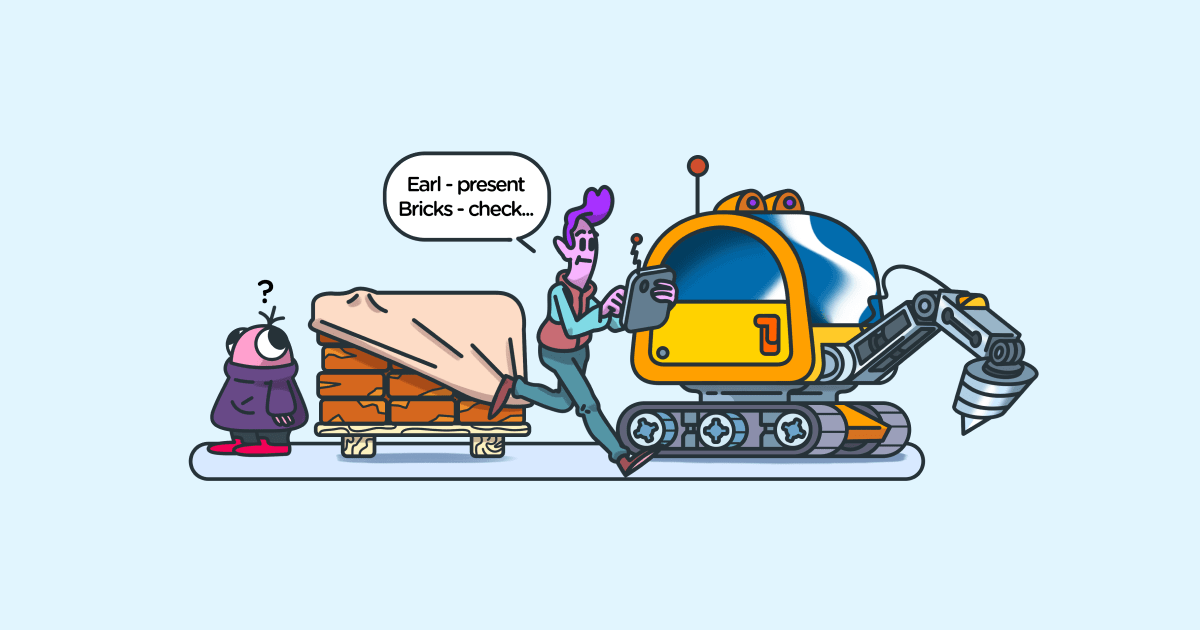How to justify your invoices to clients as a freelancer
Last updated on: March 1, 2023
We all know client communication is one of the biggest deciding factors if we ever work with them again or not. It builds trust, paints you as a professional, and you want them to know that their project is in safe hands, right? Well, justifying your invoices can play a huge part in the success of that client-freelancer relationship. It represents the building blocks of a successful long-term partnership – clients will more likely come back, recommend your services, leave positive feedback, and start trusting your judgment without question.

Table of Contents
Why should I justify my invoices?
We’ve touched upon this in the introduction, and to add to that, justifying your invoices can protect you from clients that avoid payment by making unreasonable claims. Either they’re not happy with the result for that price, or they “don’t understand” why you would charge more for revision, or disagree with your choice to take longer on a specific task.
And in case you’re still not convinced, here’s how work/project reports attached to invoices benefit your career.
Reports avoid misunderstandings
Clients come in all kinds – some are perfectly happy with you just sending an invoice, and staying out of their hair. Others want some more elaboration, because after all, it’s their money, and they want to know where it goes.
A well-structured report makes it easier to show the clients exactly what you charged and why. We can’t assume that everyone knows what our work entails. That is why simple explanations go a long way.
If your report show why you, for example, charged so many hours spent researching, you cover several possible opportunities for a misunderstanding:
- The client won’t think you’re trying to swindle them;
- You won’t come off as a procrastinator or unskilled;
- You’ll build respect due to transparency;
- There will be a written trail in case the client tries to alter the deal or the rates later on.
Maybe that specific task was a little more complex than the client let on, or you had technical issues, or simply wanted to do the best job possible, and the end result reflects that. Don’t be afraid to openly communicate your reasons for doing the tasks a specific way, and stand by your methods.
Justified invoices nurture transparency
When clients see that you’re willing to freely discuss your workflow and show them how you work, they’ll grow more confident that you have nothing to hide. Usually, people who are overly protective of their work schedules either don’t have them, are a complete mess, or aren’t up to client standards.
This only leads to distrust, and shows clients you are unwilling to answer their potential questions or take advice or suggestions. If you don’t want your invoices doubted and interrogated, then meet them halfway. Show you are a trustworthy, professional person.
Reports help build a positive reputation
As we’ve touched upon, settling into the practice of justifying your invoices through reports helps you with your industry reputation.
Happy clients are more likely to recommend you to their business partners, acquaintances, etc. Good word of mouth is often worth more than all the networking you can do.
How to justify your invoice
Justifying invoices is best done through project progress reports. The steps to building a solid report that will benefit both you and the client are fairly simple. But, it takes some preparation, and changes in habits, like filling out timesheets and tracking time on almost all tasks.
If these aren’t an issue for you, then the following process will be a breeze. Take a look at the elements your report and discussion should include.
Introduce clients to industry rates
First and foremost – your clients must know the average hourly (or per project) rate for your industry and particular branch.
You can also explain to them how rates differ depending on
Just make sure you find a reliable source of information, backed by global data. Here are some freelancing and consulting rates for 2021 that we’ve researched and compiled.
Track your time
The backbone of every good report is its timesheet.
This is where you keep all the tasks scheduled, accounted for, and track how long it takes to finish each aspect of the project you’re working on. If you’re not used to this practice, consider picking up time tracking, and find which time tracking method is best suited for you.
Now, time tracking is obviously the most useful for calculating billable and non-billable hours. But we’re not here for instructions on invoicing. We’re here to see how time tracking helps you justify it. For example, this is what a digital timesheet looks like:
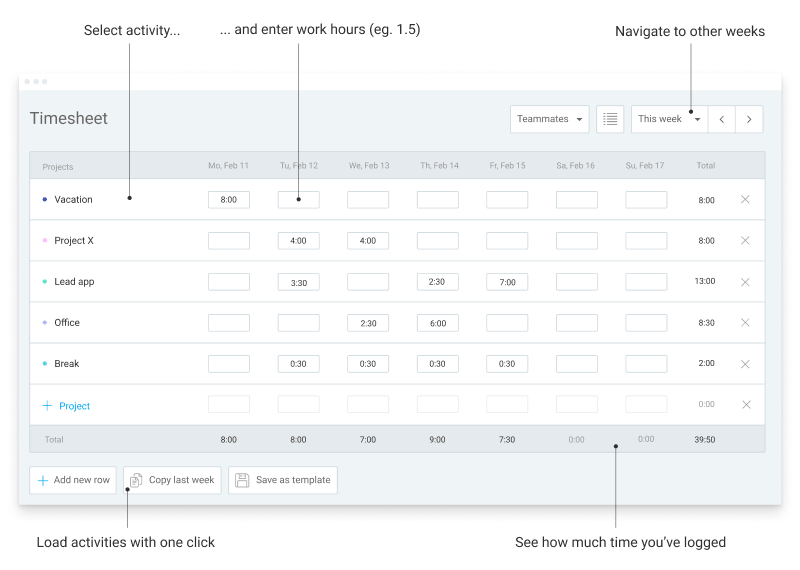
Source: Clockify.me
Now, let’s take a look at one of those entries, and how this form of time tracking helps justify invoices.
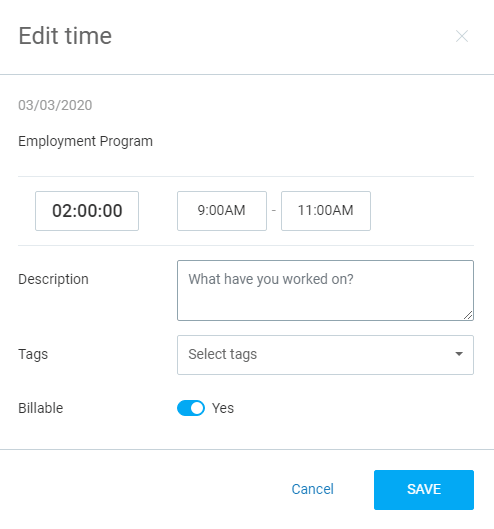
This is a detailed look at one specific time entry in Clockify. Aside from showing when you worked on a task and for how long, you also get the option to describe the process in as much detail as you want. This is perfect for preparing your reports. Simply write down how the task went, if it took longer or shorter, and why. That way, when you have to generate a report, you’ll have all the necessary information ready for the client.
Track your progress
A digital time tracker can also track your project progress.
When you start on a project, you make estimates on how long certain aspects of the project and tasks themselves will last. Through estimates, you can tell your client roughly how long it will take to finish everything.
In a digital time tracker, you can input those estimates and, as you work every day and track your time, check how they compare to actual work times. For example:
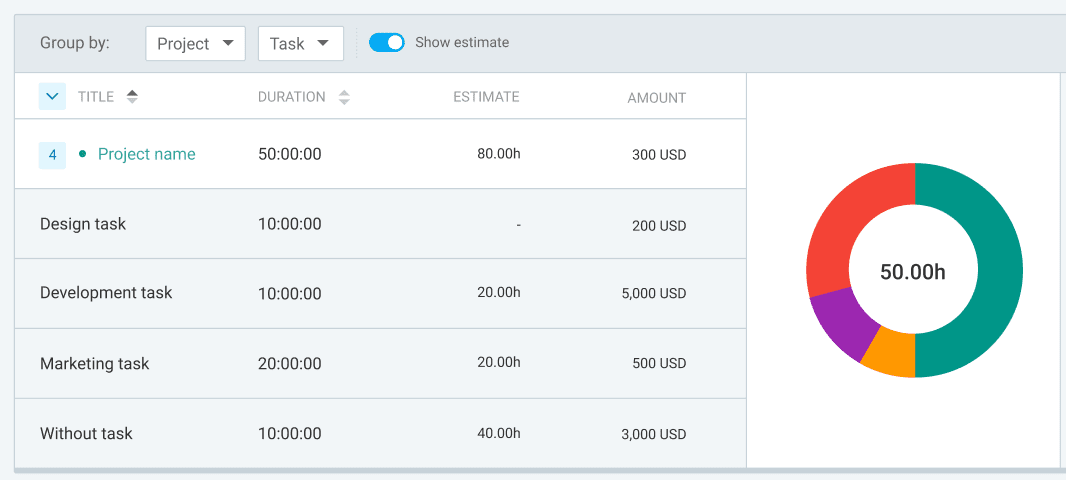
Source: Clockify.me
Some of the estimates in the entries above were that development would take 20 hours, but it took 10 hours instead, while marketing was correctly assessed. This can also be invaluable information when justifying your rates.
List any issues you had, or “bumps on the road”
Elaborate on what caused the issue, and the steps you took.
Sometimes, a task will take longer, thus ending up costing the client more. You can save yourself the stress from potential accusations or criticism by noticing and jotting down the cause of the issue before addressing it. That way, the information will stay fresh for when you have to present it to the client later on.
You can reassure them of your decisions before they’ve had the opportunity to form a negative opinion once they see the numbers.
Don’t go into too much detail
Find the perfect length and the perfect language.
Most clients won’t want to read pages of reports, no matter how demanding they are. They’ll simply ignore the report, and probably call you for a summed-up version of it. In the end, you’ve done nothing but waste time on a report no one will read.
Your best course of action would be to have a sit-down and discuss your reports with the client. Let them know what you usually track, and see what information they need or don’t need. No need for guesswork on your end, and the client knows what to expect.
Lastly, you can take a look at how we at Clockify used the time tracker to bill clients. It lists the process step by step in clear explanations.
Phrases to use when justifying your invoices
We can’t make an end-all-be-all template on how to approach your client when explaining your invoicing decisions. Not every industry is the same, nor even two freelancers in the same line of work! What we could do is give you a list of good openers and closers for your meetings, calls, and emails.
First, invite the client to a meeting
You want to establish contact with the client, so you can explain your rates and how they relate to your workflow. We’ll start off with an email template inviting the client to that particular meeting:
Hello, XY
I hope this email finds you well.
It’s a pleasure meeting you, and I look forward to working with you on this project. I’ll do my best to provide you with the results you’ll be happy with.
I’m sending you this email to suggest we set up a meeting, or a call, where I could explain a little better how I will work on this project. I believe this is an excellent way for you to share your expectations, and for me to explain why I charge these rates. You’ll get a quick and simple breakdown of my work, so you’ll know where your money goes, and rest assured there are no hidden costs.
My professional relationships are based on transparency, and I think they run much smoother when everything is out in the open.
I’m free on (DATE AND HOURS). Let me know what you think, and if any of these hours work for you.
Looking forward to hearing from you.
Kind regards,
ZY
Of course, you are free to change whatever phrase you want, to make it more personal.
Phrases to use when justifying your invoice
To keep this section short and sweet, here are some openers (and closers) you can use, both in emails and in person.
- “From experience on projects similar to this, I found that the most common problems are (XY), and take longer times to finish. So, you can expect potentially longer work times in that area.”
- “These are the average industry rates…”
- “As we’ve agreed earlier…”
- “Let me know if any part of my billing process is unclear.”
- “Thank you for taking the time to go through this with me.”
- “What aspects of the project development would you like to focus on in our progress reports?”
How to handle disputes
There are times where you will probably slip up, and miss some of these steps. Maybe you won’t prepare what was necessary for a solid report, or your client flip-flops on one of their decisions. In case you didn’t manage to avoid misunderstandings (which can often happen), there are several things you can do.
Now, there can be plenty of reasons for disputes, and the ones tied to invoicing include:
- The project took too long
- The billable hours rate wasn’t clear from the start
- There was additional work the client didn’t agree on
How do you approach an invoice dispute? How do you handle justifying your invoice professionally?
1. Analyze the situation
Your first instinct should be to identify who made the oversight – you, or the client.
If you are the one who caused the misunderstanding, send them an apology email assuring them you will see to fixing the issue. This works for when the problem is in the final product:
- They aren’t satisfied with the product quality
You go back to the drawing board with new directions, but also let them know you will invoice again and charge for the additional time. Be very clear concerning this, as some will try to avoid paying because they just “don’t like” your work, despite the revisions.
Below is an example of a great, calm handling of one such situation.
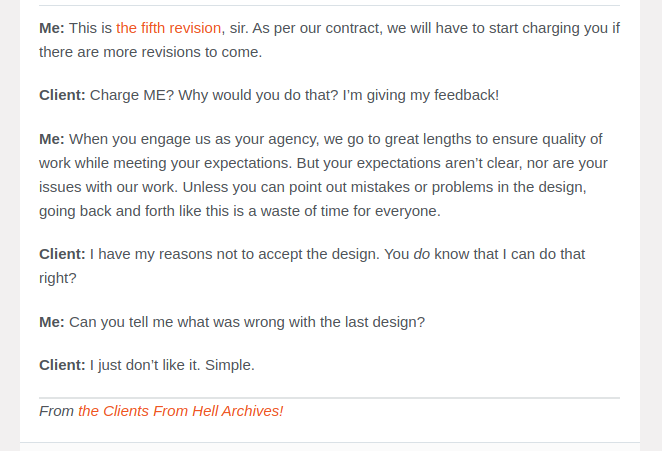
Source: Clientsfromhell.net
- They don’t understand why some things took too long or too little
To combat this, you should pull up your reports, timesheets, and all the notes you’ve hopefully written as you worked on the project. Arrange a meeting or a call, showing a willingness to justify your invoice and the choices you made.
If the client is the one behind the misunderstanding, there are again, two ways to go about it:
- Accidentally causing a problem
Usually due to forgetting to ask important questions early on, or failing to remember things you agreed upon. A simple email reminding them of your agreements, sections of the contract, and any email exchanges you had will jog their memory.
- Purposefully causing a problem
These are usually clients who get miserly with their money. Bringing up complaints after-the-fact is just fancified flea market bartering. While clients like these can be rare, every freelancer has met them at least once or twice in their life.
Keeping neat documentation has saved plenty of freelancers before the clients had a chance to wriggle out of paying. Even considering lawyer involvement should be your go-to in extreme cases. You deserve to get paid.
2. Have proof at the ready
This entire time we’ve emphasized how important it is to document everything. It’s the only way to see that your work, reputation, and payment are protected.
Don’t delete emails, make screenshots of texts and chat logs, and summaries of meetings or calls.
⚠️ Important note:
Refrain from recording meetings and calls without the client’s knowledge, as it is illegal! You should ask for consent to record anything first. If they refuse, simply type up a summary of what you agreed upon during the meeting/call, and forward them the email. Ask them to see if your summary is correct, and if they confirm, you just made one more “paper trail” that could potentially work in your favor.
3. Remain civil
No matter how the client reacts, nothing beats civility and good manners.
As hard as it may be, remain cool-headed even when the person gets stubborn, or simply can’t understand what you’re trying to communicate. Coming from personal experience, we’ve composed a list of templates on asking the client for payment without being rude.
Conclusion
Justifying invoices shouldn’t come as an afterthought when the client starts to suspect your work ethics. To prevent this from happening, you should actually justify your invoices early on, almost at the very beginning of your partnership. When clients know why you charge as much as you do from the get-go, they’re less likely to make any alterations or complaints later on.
Keeping tight and detailed documentation (timesheets, emails, and reports) also ensures you have leverage should a dispute come out. Ultimately, brief breakdowns of your pricing process help build trust through transparency. Clients are more likely to work with you again, and even recommend you to their peers.
Do you have any practices of your own? Share your experiences with us at blogfeedback@clockify.me and we could feature you in one of our next articles.





